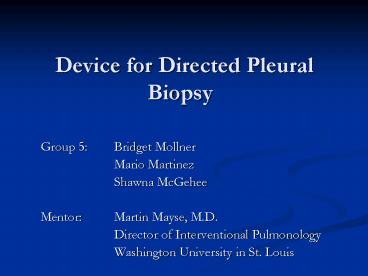Device for Directed Pleural Biopsy - PowerPoint PPT Presentation
1 / 19
Title:
Device for Directed Pleural Biopsy
Description:
Confocal Microscopy ... Confocal Microscopy. Pros: can be used to see through milky solution ... Confocal Microscopy. Fluor. Tagging. Infrared Tech. LIDAR ... – PowerPoint PPT presentation
Number of Views:157
Avg rating:3.0/5.0
Title: Device for Directed Pleural Biopsy
1
Device for Directed Pleural Biopsy
- Group 5 Bridget Mollner
- Mario Martinez
- Shawna McGehee
- Mentor Martin Mayse, M.D.
- Director of Interventional Pulmonology
- Washington University in St. Louis
2
Background
- Why a device for Directed Pleural Biopsy?
- 1.5 million people develop pleural effusions each
year. - Current surgical procedures have not changed in
the last couple decades. - It is a very difficult condition to diagnose.
University of California, San Diego
http//meded.ucsd.edu/isp/1994/im-quiz/pleuaden.ht
m
3
Background
- Design a useful device or method that is
- Used to obtain a biopsy of the parietal pleura
(1mm range in size) - Directed by imaging to determine the abnormal
tissues - Does not require a chest tube to be left in the
patient
4
Background
- Design Specifications
- The size of the insertion hole should be less
than 5 mm in diameter - The procedure must be able to obtain a biopsy
that is in the 1mm range - Length of device needs to be less than 45 cm
- The weight of the device should be less than 2 kg
- Materials used should be biocompatible, suck as
plastic, silicone, teflon - Budget under 20,000
- General anesthesia should not be required
- Patient should be able to go home that day after
surgery
5
Design Alternatives
- Light Detection and Ranging (LIDAR)
- measures properties of scattered light to find
range and/or other information of a distant
target - Pros ability to see through smoke
- Cons size of device image produced cost
Witness and Response September 11 Acquisitions
at the Library of the Congres (Geography and Map
Division) http//www.loc.gov/exhibits/911/911-maps
.html LIDAR http//www.jhu.edu/dogee/mbp/researc
h/lidar/main.htm
6
Design Alternatives
- Confocal Microscopy
- A laser beam is passed through the endoscope
using an optical fiber, and an image is obtained
by filtering out light from regions that are not
in focus.
EndoMicroscopy http//www.endomicroscopy.org/Tour/
normal/4.asp
7
Design Alternatives
- Confocal Microscopy
- Pros can be used to see through milky solution
- Cons price, unsure if itll work through pleural
fluid, unsure as to what its magnification can be
Synthetic Aperture Confocal Imaging
http//graphics.stanford.edu/papers/confocal/levoy
-confocal-sig04.pdf
8
Design Alternatives
- Fluorescent Tagging
- Photosensitizers (which have high binding
specificity to tumor cells) are taken into the
body and are exposed to blue light (380-440 nm)
under which they fluoresce. - Pros safe, easy to add this wavelength to
current technology - Cons best results 6 hrs of taking
photosensitizers, little research in pleural
space, FDA
R L Prosst, S Winkler, E Boehm, J Gahlen.
Thoracospcoic Fluorescence Diagnosis of Pleural
Malignancies Experiemental Studies. Thorax.
2002 57, 1005-1009
9
Design Alternatives
- Balloon on a Stick (BOS) system
- A balloon is filled with saline, so that the
pleural walls can be imaged through a clear
solution, avoiding absorption from the
potentially colored and cloudy pleural fluid - Pros simple, inexpensive
- Cons loosing balloon in patient, overall safety
EP Lab Digest. http//www.eplabdigest.com/article
/974
10
Design Alternatives
- Infrared Technology
- Temperature measurements allow physiological or
pathological changes in the tissue to be
detected. Therefore, abnormal tissues in the
pleural space can be detected. - Pros good visualization on real time basis can
see through flowing blood safe for use in humans - Cons can we identify other abnormal tissues
beyond cancerous tumor cells?
http//www.cardio-optics.com/video.asp
11
Design Alternatives
- Ultrasound
- Uses high frequency sound waves that are
reflected by tissue to varying degrees to produce
a 2D or 3D image, traditionally on a TV monitor - Pros small transducers available familiar
images flexibility as to frequency (high
frequency ultrasounds - Cons size of device interpreting signals
training required
Ultrasound http//en.wikipedia.org/wiki/Ultrasound
12
Choosing a Design
- Develop Criteria and Weights
- Brainstorming as individual and in groups
- Came up with 16 different criteria
- Ranked them individually (from 1 to 16)
- Use Average Ranking to Assign Weights
- Rank 1, Weight 10
- Rank 2, Weight 9
13
Choosing a Design
14
Choosing a Design
- Assess how each Technology performs according to
each criteria - If technology fulfills criteria well, Assign a 5
- If technology does not fulfill criteria well,
Assign a 1 - Each person does assessment, then we average
results - Multiply AVG Assessment with weights, and sum
points
15
Choosing a Design
16
Infrared Technology
- Chosen because it provides a good image, is safe,
is relatively inexpensive, and its easy to adjust
to current tools (use fiber optics) - Other considerations
- License Technology (US Patent 6,178,346)
- Image Output Device
- Further Specifications
- Wavelength 1600 nm
- Yellow or Red pleural fluid absorb wavelengths in
the range of 420 to 500nm
17
Design Schedule
18
Team Responsibilities
- Bridget Mollner
- Overall Device Design
- Mario Martinez
- Webpage
- Light Source
- Shawna McGehee
- Detection and Imaging
19
QUESTIONS?































